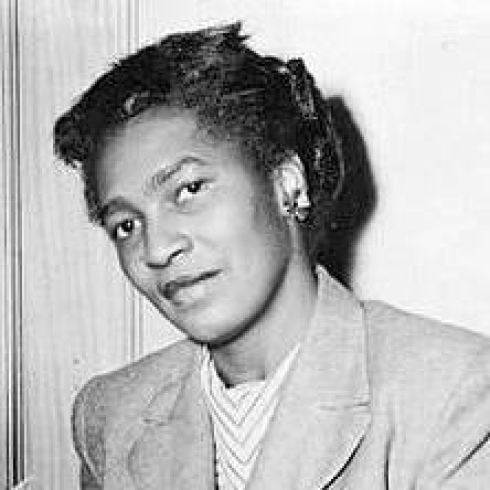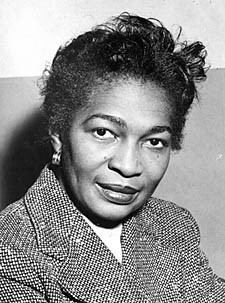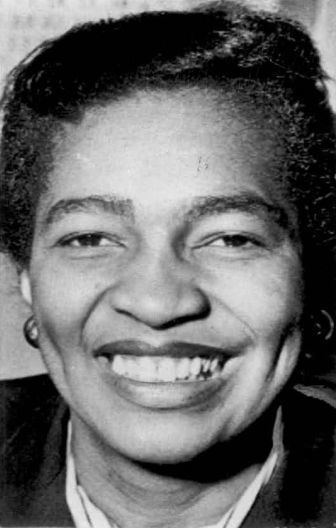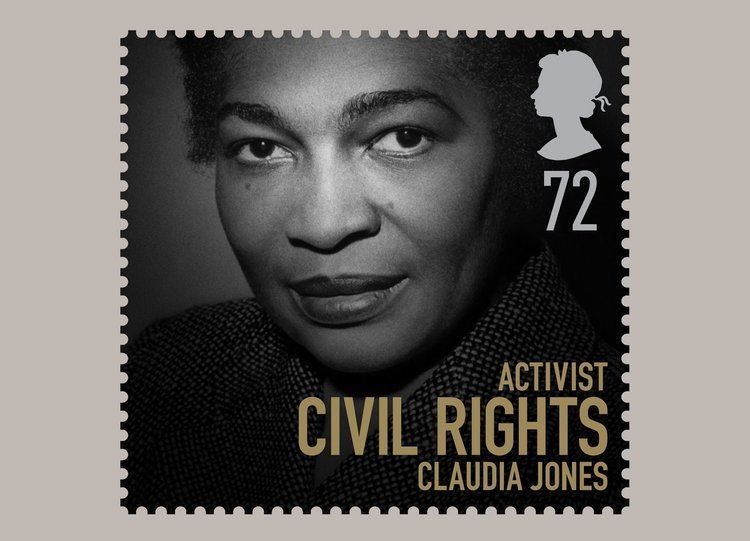Nationality Trinidadian Role Journalist Occupation Journalist | Years active 1936–1964 Name Claudia Jones | |
 | ||
Full Name Claudia Cumberbatch Jones Family Mother, Father and two sisters Died December 24, 1964, London, United Kingdom | ||
Claudia Jones
Claudia Jones, née Claudia Vera Cumberbatch (21 February 1915 – 24 December 1964), was a Trinidad-born journalist and activist. As a child she migrated with her family to the US, where she became a political activist and black nationalist through Communism, using the false name Jones as "self-protective disinformation". As a result of her political activities, she was deported in 1955 and subsequently resided in the United Kingdom. She founded Britain's first major black newspaper, The West Indian Gazette (WIG), in 1958.
Contents
- Claudia Jones
- Claudia jones the black woman that created london carnival
- Early life
- United States career
- An End to the Neglect of the Problems of the Negro Woman
- Deportation
- United Kingdom career
- Activism
- The West Indian Gazette and Afro Asian Caribbean News 1958
- Notting Hill riots and Caribbean Carnival 1959
- Death
- Legacy
- Commemoration of the 100th anniversary of her birth
- References

Claudia jones the black woman that created london carnival
Early life

Claudia Vera Cumberbatch was born in Belmont, Port of Spain, Trinidad, on 21 February 1915. When she was nine years old, her family emigrated to New York City following the post-war cocoa price crash in Trinidad. Her mother died five years later, and her father eventually found work to support the family. Jones won the Theodore Roosevelt Award for Good Citizenship at her junior high school. In 1932, due to poor living conditions, she was struck with tuberculosis, a condition that irreparably damaged her lungs and plagued her for the rest of her life. She graduated from high school, but her family was so poor that they could not afford to attend the graduation ceremony.
United States career

Despite being academically bright, classed as an immigrant woman she was severely limited in her career choices, and so instead of going to college Jones began working in a laundry, and subsequently found other retail work in Harlem. During this time she joined a drama group, and began to write a column called "Claudia Comments" for a Harlem journal.

In 1936, trying to find organisations supporting the Scottsboro Boys, she joined the Young Communist League USA. In 1937 she joined the editorial staff of the Daily Worker, rising by 1938 to become editor of the Weekly Review. After the Young Communist League became American Youth for Democracy during World War II, Jones became editor of its monthly journal, Spotlight. After the war, Jones became executive secretary of the Women's National Commission, secretary for the Women's Commission of the Communist Party USA (CPUSA), and in 1952 took the same position at the National Peace Council. In 1953, she took over the editorship of Negro Affairs.
"An End to the Neglect of the Problems of the Negro Woman!"
Jones' best known piece of writing, "An End to the Neglect of the Problems of the Negro Woman!", appeared in 1949 in the magazine Political Affairs. It exhibits her development of what later came to be termed "intersectional" analysis within a Marxist framework. In it, she wrote:
The bourgeoisie is fearful of the militancy of the Negro woman, and for good reason. The capitalists know, far better than many progressives seem to know, that once Negro women begin to take action, the militancy of the whole Negro people, and thus of the anti-imperialist coalition, is greatly enhanced.
Historically, the Negro woman has been the guardian, the protector, of the Negro family.... As mother, as Negro, and as worker, the Negro woman fights against the wiping out of the Negro family, against the Jim Crow ghetto existence which destroys the health, morale, and very life of millions of her sisters, brothers, and children.
Viewed in this light, it is not accidental that the American bourgeoisie has intensified its oppression, not only of the Negro people in general, but of Negro women in particular. Nothing so exposes the drive to fascization in the nation as the callous attitude which the bourgeoisie displays and cultivates toward Negro women.
Deportation
An elected member of the National Committee of the Communist Party USA (CPUSA), Jones also organised and spoke at events. As a result of her membership of CPUSA and various associated activities, in 1948 she was arrested and sentenced to the first of four spells in prison. Incarcerated on Ellis Island, she was threatened with deportation to Trinidad.
Following a hearing by the Immigration and Naturalization Service, she was found in violation of the McCarran Act for being an alien (non-US citizen) who had joined the Communist Party. Several witnesses testified to her role in party activities, and she had identified herself as a party member since 1936 when completing her Alien Registration on 24 December 1940, in conformity with the Alien Registration Act. She was ordered to be deported on 21 December 1950.
In 1951, when aged only 36 and in prison, she suffered her first heart attack. That same year, she was tried and convicted with 11 others, including her friend Elizabeth Gurley Flynn, of "un-American activities" under the Smith Act, specifically activities against the United States government. The Supreme Court refused to hear their appeal. In 1955, Jones began her sentence of a year and a day at the Federal Reformatory for Women at Alderson, West Virginia. She was released on 23 October 1955.
She was refused entry to Trinidad and Tobago, in part because the British colonial governor Major General Sir Hubert Elvin Rance considered that "she may prove troublesome". She was eventually offered residency in the United Kingdom on humanitarian grounds, and federal authorities agreed to allow that when she agreed to cease contesting her deportation. On 7 December 1955, at Harlem's Hotel Theresa, 350 people met to see her off.
United Kingdom career
Jones arrived in London two weeks later, at the time of the building of the Empire Windrush community, and vast expansion of the British African-Caribbean community. However, on engaging the political community that she had just left in the United States, she was disappointed to find that many British communists were hostile to a black woman.
Activism
Landing in England at a time when many landlords, shops and even some government establishments displayed signs saying "No Irish, No Coloured, No Dogs", Jones found a community that needed active organisation. She began to get involved in the British African-Caribbean community to organise both access to basic facilities, as well as the early movement for equal rights.
Supported by her friends Trevor Carter, Nadia Cattouse, Amy Ashwood Garvey, Beryl McBurnie, Pearl Prescod and her lifelong mentor Paul Robeson, Jones campaigned against racism in housing, education and employment. She addressed peace rallies and the Trade Union Congress, and visited Japan, Russia, and China, where she met with Mao Zedong.
In the early 1960s, despite failing health, Jones helped organise campaigns against the 1876 Immigration Act, which would make it harder for non-Whites to migrate to Britain. She also campaigned for the release of Nelson Mandela, and spoke out against racism in the workplace.
The West Indian Gazette and Afro-Asian Caribbean News, 1958
From her experiences in the United States, Jones knew that "people without a voice were as lambs to the slaughter." Therefore, in 1958 above a barber's shop in Brixton, she founded and thereafter edited the anti-imperialist, anti-racist paper, The West Indian Gazette and Afro-Asian Caribbean News (WIG). The paper became a key contributor to the rise of consciousness within the Black British community.
Jones wrote in her last published essay, "The Caribbean Community in Britain", in Freedomways (Summer 1964):
Always strapped for cash, WIG folded eight months and four editions after Jones's death in December 1964.
Notting Hill riots and "Caribbean Carnival", 1959
Four months after launching WIG, racial riots broke out in August 1958 in Notting Hill, London and in Robin Hood Chase, Nottingham. In view of the racially driven analysis of these events by the existing British daily newspapers, Jones began receiving visits from members of the black British community and also from various national leaders responding to the concern of their citizens, including Cheddi Jagan of British Guiana, Norman Manley of Jamaica, Eric Williams of Trinidad and Tobago, as well as Phyllis Shand Allfrey and Carl La Corbinière of the West Indies Federation.
As a result, Jones identified the need to "wash the taste of Notting Hill and Nottingham out of our mouths". It was suggested that the British black community should have a carnival; it was December 1958, so the next question was: "In the winter?" Jones used her connections to gain use of St Pancras Town Hall in January 1959 for the first Mardi-Gras-based carnival, which was directed by Edric Connor and headlined the Boscoe Holder Dance Troupe, jazz guitarist Fitzroy Coleman and singer Cleo Laine; and was televised nationally by the BBC. These early celebrations were epitomised by the slogan: "A people's art is the genesis of their freedom."
A footnote on the front cover of the original 1959 souvenir brochure states: "A part of the proceeds [from the sale] of this brochure are to assist the payments of fines of coloured and white youths involved in the Notting Hill events." Jones and the West Indian Gazette also organised five other annual indoor Caribbean Carnival cabarets at such London venues as Seymour Hall, Porchester Hall and the Lyceum Ballroom, which events are seen as precursors of the celebration of Caribbean Carnival that culminated in the Notting Hill Carnival.
Death
Jones died on Christmas Eve 1964, aged 49, and was found on Christmas Day at her flat. A post-mortem declared that she had suffered a massive heart attack, due to heart disease and tuberculosis.
Her funeral on 9 January 1965 was a large and political ceremony, with her burial plot selected to be that located to the left of her hero, Karl Marx, in Highgate Cemetery, North London. A message from Paul Robeson was read out:
Legacy
The National Union of Journalists' Black Members' Council holds a prestigious annual Claudia Jones Memorial Lecture every October, during Black History Month, to honour Jones and celebrate her contribution to Black-British journalism.
The Claudia Jones Organisation was founded in London in 1982 to support and empower women and families of African-Caribbean heritage.
Winsome Pinnock's 1989 play A Rock in Water was inspired by the life of Claudia Jones.
Jones is named on the list of 100 Great Black Britons (2003).
In August 2008, a blue plaque was unveiled on the corner of Tavistock Road and Portobello Road commemorating Claudia Jones as the "Mother of Caribbean Carnival in Britain".
In October 2008, Britain's Royal Mail commemorated Jones with a special postage stamp.
She is the subject of a documentary by Z. Nia Reynolds, Looking for Claudia Jones.
Commemoration of the 100th anniversary of her birth
Various activities took place from June 2014 onwards. The most successful were possibly those organised by Community Support, which put substantial resources into basic research into aspects of her life and work.
This led to new revelations and rediscoveries about Claudia Jones, not included in the three printed biographies, or the film biography.
Community Support organised A Claudia Jones 100 Day on the 100th anniversary of her birth at Kennington Park Estate Community Centre on Saturday 21 February 2015. This began with a guided tour showing her two main residences while she lived in London, and the former West Indian Gazette office nearby.
There was also a celebration at The Cloth, in Belmont, Port of Spain, Trinidad and Tobago, near to her birthplace, on the same day.
The Day was associated with an event held on the previous evening at Claudia Jones Organisation in Hackney, which featured a screening of the film Looking for Claudia Jones by Z. Nia Reynolds.
